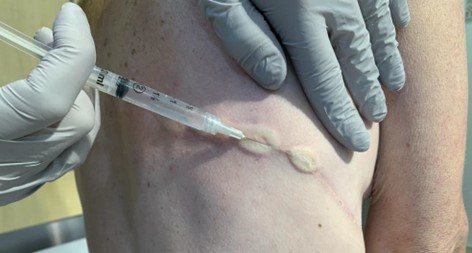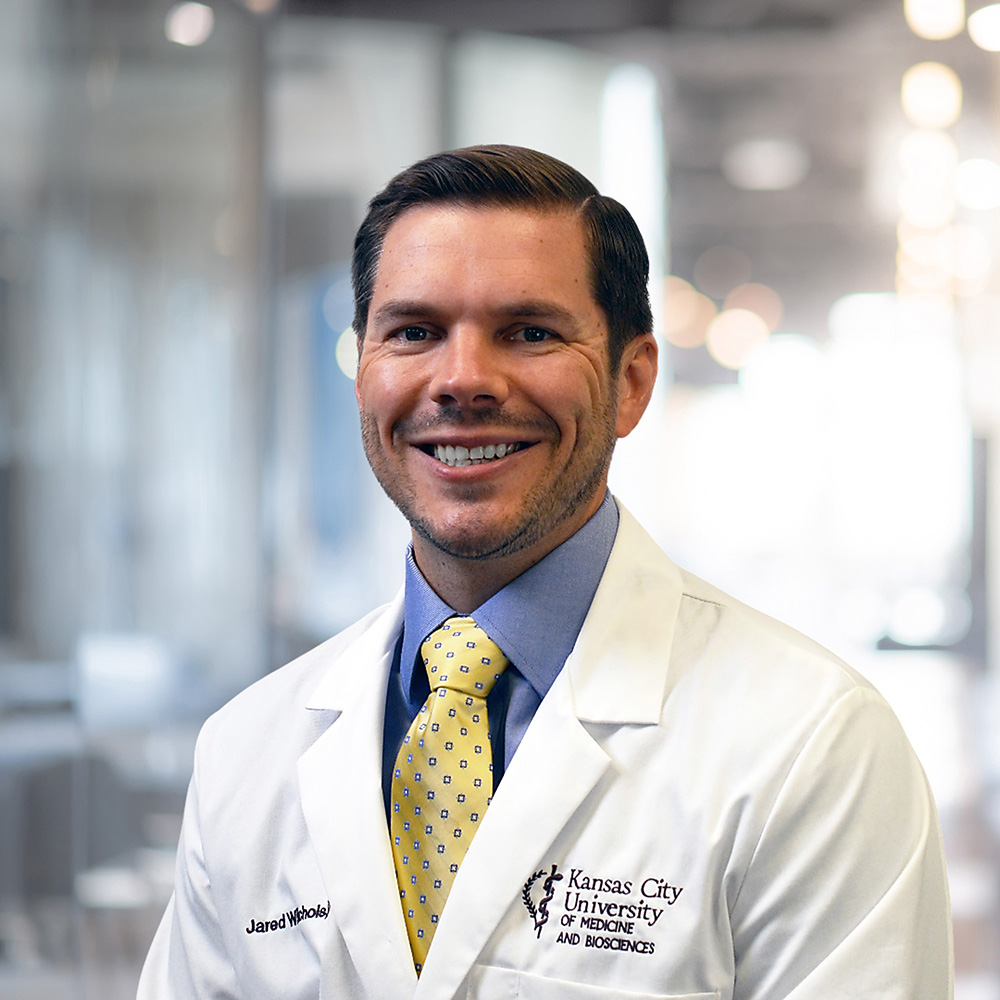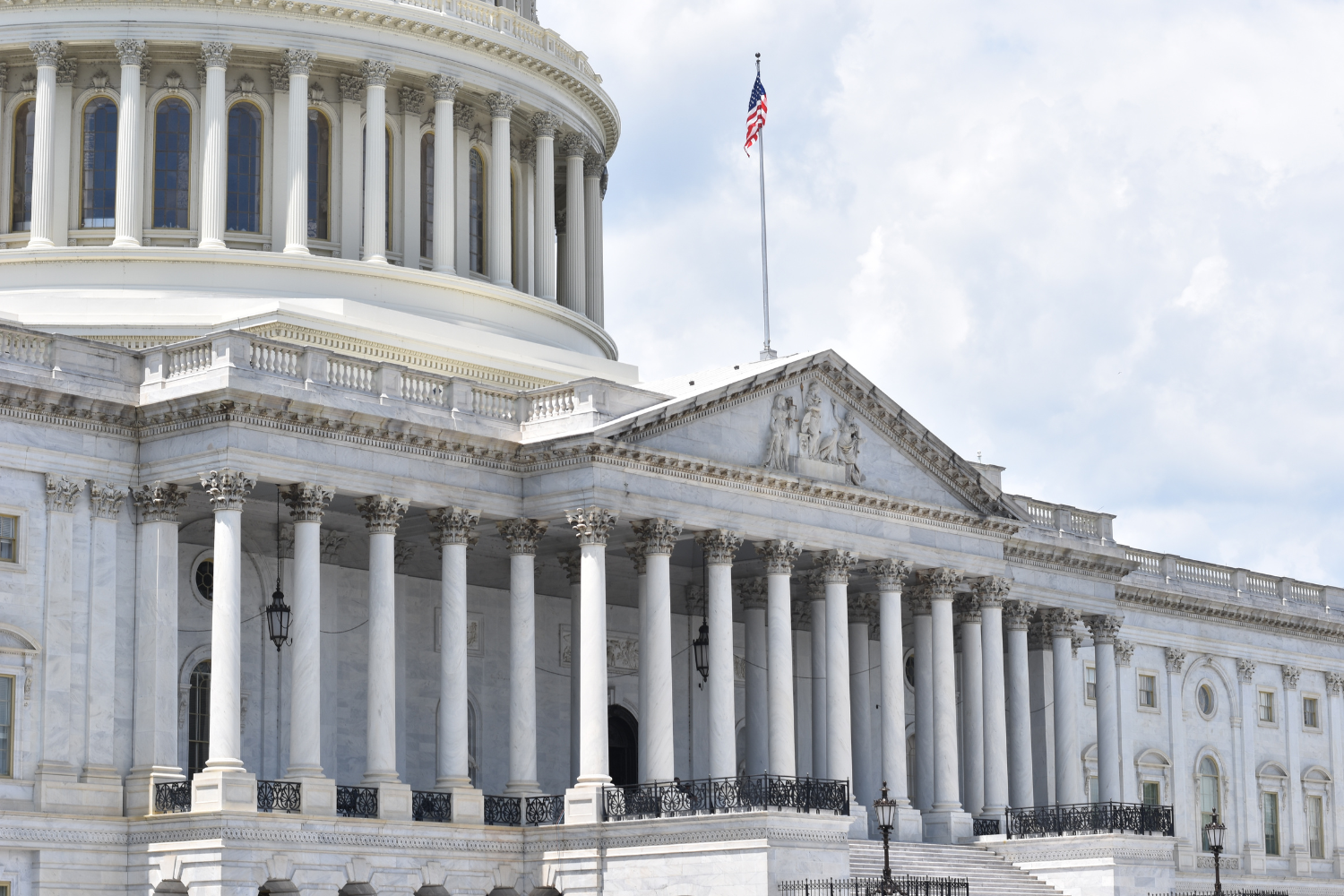This paper was submitted as part of Dr. Nichols's application for ACOFP Fellowship, which recognizes exceptional national, state, and local service through teaching, authorship, research, or professional leadership. Visit the ACOFP Fellows page to learn more about fellowship and the nomination process.
Key Words: Post-mastectomy Pain Syndrome, Scar Pain, Scar Injection, Post-Surgical Pain, mastectomy pain
ABSTRACT
Breast cancer affects nearly one in eight women, with mastectomy and reconstruction leading to sequelae that may negatively impact a woman’s quality of life and overall well-being.1 While there are several methods and case studies over the topic, injection of anesthetics directly into the scar tissue for post-mastectomy pain syndrome has not been as extensively studied. In this case report, a 49-year-old female with right upper back pain refractory to several other types of treatment was injected with a 1:1:1 mixture of 2% Lidocaine, 0.5% Bupivacaine, and sterile water over the course of several months on a bi-weekly basis and exhibited great improvement in her pain, decreased medication use, and increase in her reported overall quality of life. After several treatments, the patient reported lasting pain relief and began to experience new sensations in areas that were previously hypoesthetic. Additionally, the general appearance of the scar was found to have visibly improved post-treatment (flattening and decreased redness). Given these results, more studies are needed regarding the effectiveness of scar injection to post-mastectomy pain syndromes and patients with chronic symptomatic scar pain.
INTRODUCTION
Breast cancer is a disease affecting nearly one in eight women. That can prove to be debilitating and a source of morbidity.1 Following a mastectomy, women can experience post- mastectomy pain syndrome (PMPS) as a complication, with prevalence ranging from 25-60%.2,3,4 These symptoms may arise immediately after the procedure and can persist for more than three months post- mastectomy.3 Additionally, the scars left behind from such treatments can lead to a wide array of symptoms such as pain, burning, or paresthesia in the area hypothesized to be due to a disruption of the membrane potential in the cell.5 Uniquely in PMPS, the pain is most often localized to the anterior or lateral thoracic region, and may involve the axilla and/or medial portion of the upper arm.3 Those more likely to be affected by PMPS are typically younger, undergo axillary lymph node dissection (compared to sentinel lymph node dissection), and adjuvant radiotherapy.3,4,6
Living with a chronic pain syndrome can lead to an exceptional decline in a patient’s quality of life and return to functional baseline – both of which are of great importance to the patient. Osteopathic manipulative therapy (OMT) has been studied regarding chronic pain as well as the post-mastectomy setting, with several techniques shown to be beneficial in reduction of overall pain and lymphedema.7-9 Several other treatment modalities regarding these pain syndromes have been suggested and include pre-incisional paravertebral blocks, thoracic paravertebral nerve block, serratus plane block, radiofrequency ablation, topical capsaicin, fat injection, antidepressants and anti-epileptics.10-19 Scar injections, while not extensively studied with regard to PMPS, could provide an additional therapeutic alternative. Superficial injection of the scar with anesthetic agents may provide immediate and long- term relief of pain from disrupted cell membranes, leading to an improved quality of life with decreased morbidity.7,18,19 Relief from these injection methods have been compared to treatment of somatic dysfunctions with OMT.20
In the patient presenting with possible PMPS, the differential diagnosis could include somatic dysfunction of the rib, shoulder, upper extremity, or thoracic region, costochondritis, metastasis from cancer, nerve hypersensitivity, and neuroma in the underlying scar region.
PATIENT INFORMATION AND HISTORY OF CHIEF COMPLAINT
The patient is a 49-year-old Caucasian female status post bilateral nipple-sparing mastectomy in 2014. Her recovery was complicated with a Staphylococcus aureus infection and multiple breast reconstruction and scar revision efforts (total of 14 surgeries/procedures including chest tubes, breast revision, debridement capsulectomy, and scar revision over the course of three years). Her chief complaint included chronic, constant, sharp, right- sided pain in the ribs and upper back and breast which she noted to greatly interfere with her quality of life and were refractory to pharmacologic, interventional, and traditional medical treatment. She also reported the thoracic/rib pain exacerbated her chronic migraines for which she takes topiramate 100 mg BID and Botox injections, all with minimal relief.
The patient had previously tried epidural steroid injections X 4 (minimal relief), intercostal nerve blocks X 2 (sustained relief for several days of thoracotomy scar but no relief of breast pain), osteopathic manipulative treatment and acupuncture (some relief for 12 hours per visit), and medications including duloxetine, pregabalin, gabapentin, amitriptyline, prednisone, and oxycodone. The patient was the sole caregiver for four children and chose to discontinue most medications due to inadequate pain relief and severe “brain fog.”
Past Relevant Surgical History
Bilateral nipple-sparing mastectomy and breast reconstruction with later implant revision, wound debridement, latissimus dorsi flap reconstruction, and scar revision surgery to the right breast (14 surgeries total). History of tubal ligation, tonsillectomy, heart catheterization, and nasal/sinus surgery.
Medications
Diazepam 5mg for anxiety, topiramate 100mg twice daily and frovatriptan 2.5mg as needed for migraines, tizanidine 4mg as needed for muscle spasms, promethazine 25mg as needed for nausea.
Pertinent Physical Exam on Initial Visit
The patient presented with blood pressure, pulse, respiratory rate, and body mass index within normal limits. Musculoskeletal examination reveals tenderness to the right upper back and chest region, with decreased range of motion to the upper cervical spine and ribcage. Additional examination revealed tenderness to the surgical scar sites as well as pain in bilateral breast regions. Osteopathic examination revealed multiple chronic dysfunctions and compensations.
Assessment
1) Right-sided chest wall pain; 2) Pain in surgical scar; 3) PMPS; 4) History of Staphylococcus aureus infection; 5) Ophthalmoplegic migraine, not intractable; 6) somatic dysfunction of the cervical region, head region, lumbar region, pelvis region, rib cage, sacrum, and upper extremity.
Initial Plan
Based on the physical examination and past patient history, the patient received OMT during the initial visit. This included articular techniques, indirect balanced ligamentous tension, cranial osteopathy, visceral manipulation, counterstrain, and integrated neuromuscular release. She was given at home exercise and stretching recommendations for the neck and arms with instructions to follow up in four weeks. On follow up, the patient reported that the OMT had made her pain worse. She was interested in attempting an alternative therapy for her constant, burning scar pain.
First Injection Procedure
After patient education and consent, the patient was placed in a supine and lateral recumbent position, and examined for myofascial spasm. Next, she was prepped utilizing aseptic technique. Subsequently, a 27-gauge, 1.5 inch needle was advanced into the tender points and surgical scars (intradermally) and 2% Lidocaine, 0.5% bupivacaine, and sterile water prepared in a 1:1:1 mixture was injected. The patient noted an immediate improvement in pain and sensation after injection and was advised to return for follow-up in two weeks for re-evaluation and for possible additional injection if any lasting benefit (longer than the physiologic efficacy of injected anesthetics).
OUTCOMES
Two-Week Follow-up #1
Upon returning to the clinic two weeks after scar and trigger point injections, the patient was still in considerable pain. However, she reported near complete relief for approximately 2.5 days following the procedure (Note: the half-life of bupivacaine is 2.7 hours). The lidocaine cream provided relief for approximately fifteen minutes. She was interested in repeating the scar and trigger point injection procedure. (The author would like to note that the decision to repeat the injection was made as the patient reported relief lasting well beyond the known efficacy of the local anesthetics, supporting the theory of nerve hypersensitivity and desensitization with injected anesthetics. Had the patient not had relief well beyond the known length of anesthetic action, the injections would not have been repeated and a different course of therapy would have been pursued.)
The injections were repeated, as demonstrated in Figure 1. The patient noted immediate improvement in pain. Musculoskeletal findings also improved immediately post-procedure and she was advised to follow-up again in two weeks.
Figure 1: Injection of symptomatic thoracostomy scar using a 3cc syringe and a 27 gauge, 1.5” needle.

Two-Week Follow-up #2
The patient reported that she was having pain in the scars of the other breast now, which had never happened before. She reported complete relief for approximately 30 hours with a slow regression and return of her sharp pain after this treatment. She declined nerve ablation at this time and was interested in continuing scar injection. The injection procedure was again repeated with immediate improvement noted and recommended two-week follow-up.
Two-Week Follow-up #3
The patient reported continued improvement of her scar and back pain, with complete relief lasting for a week this time. The only adverse effect noted from the procedure was some bruising. Injection to the surgical scars were again performed with two-week follow-up advised.
Interestingly after injection, the patient noted that, while her surgical scar pain went away, she began having pain in other scar sites where biopsies had previously been performed. These sites were completely unrelated to the areas being injected.
Two-week Follow-up #4
The patient notes that the injections have given her complete relief for several days at a time, with the time of relief increasing with each visit. She now notes that she is beginning to have sensation to the left nipple where she previously had none. She is excited about the improvement, but notes that she still has the sharp, stabbing pain in between visits but describes the pain as intermittent instead of constant. Injection therapy was performed with two-week follow-up recommended.
Two-week Follow-up #5
At this visit, the patient noted that she is having “improvement of 90%” after injections. Trigger point and scar injections were performed. Injection therapy was directed at the scars which were painful. Areas that were previously painful were now noted to be pain-free and were not injected.
Two-week Follow-up #6
The patient states that scar injections “have been the only thing that has made a major impact on her pain.” Prior to the injection therapy, she had experienced constant sharp, stabbing pain but reports that now her pain is dull and achy in nature. This has made quite an impact on her quality of life. She now reports having no pain in the left nipple at all, just pain under the breast with continued interest in injection therapy. During this visit, the surgical scars were noted to appear much improved by both the physician and the patient.
PATIENT PERSPECTIVE
Overall, the patient was highly satisfied with receiving injections. Upon interview for this case report, she noted her overall pain is “a lot better,” the “intensity is way less, and less frequent.” Her pain quality has changed from a constant sharp and throbbing sensation to an intermittent dull and achy annoyance and admits that she has been able to decrease her pain medications considerably since beginning injection therapy. She regrets that she did not start this process sooner and wishes that she would have had the option to try this procedure before more invasive spinal injections or prior to starting medications with multiple side effects. From her perspective, this has been the “safest, most beneficial” intervention she has tried, and it is “leaps and bounds better than anything else” she had done.
DISCUSSION
While initial injection procedures merely yielded improvement for a couple of days, continued scar and trigger point injection therapy revealed longer duration of relief as treatments progressed. Additionally, the patient began to experience sensation in the left nipple region, an area which she had previously not experienced sensation prior to therapy. After a couple of months of injection therapy, her quality of life improved greatly and a change in the type of pain experienced also changed. The patient went from a constant sharp, stabbing pain to an intermittent dull, achy pain.
These results suggest that the theory of decreasing long-term nerve hypersensitivity with anesthetics may be a contributing factor to this patient’s presentation. Furthermore, the risk of intradermal injections with anesthetics is quite low. The author believes a trial of anesthetic injections in areas of trauma, refractory to other treatment is a low-risk and cost-effective treatment option that has the potential to yield great results. More studies should be completed regarding scar and trigger point injection therapy, as great improvement in quality of life and scar appearance have been seen in a very short amount of time.
Informed Consent: Patient verbal and written consent was received for reporting of this case and image.
REFERENCES
- Vadivelu N, Schreck M, Lopez J, Kodumudi G, Narayan D. Pain after mastectomy and breast reconstruction. American Surgeon. 2008 Apr;74(4): 285-296.
- Andersen KG, Kehlet H. Persistent pain after breast cancer treatment: a critical review of risk factors and strategies for prevention. J Pain. 2011 Jul;12(7):725-46. doi:10.1016/j.jpain.2010.12.005
- Fabro EA, Bergmann A, Silva BA, et al. Post-mastectomy pain syndrome: Incidence and risks. Breast. 2012 Jun;21(3):321-25. doi: https://doi.org/10.1016/j.breast.2012.01.019
- Couceiro TC, Valença MM, Raposo MC, Orange FA, Amorim MM. Prevalence of post- mastectomy pain syndrome and associated risk factors: A cross-sectional cohort study. Pain Manag Nurs. 2014 Dec;15(4):731-7. doi: 10.1016/j.pmn.2013.07.011. Epub 2013 Oct 19.
- Kidd RF. Neural Therapy: Applied Neurophysiology and Other Topics. Canada: Custom Printers of Renfrew Ltd; 2005.
- Gärtner R, Jensen MB, Nielson J, Ewertz M, Kroman N, Kehlet H. Prevalence of and factors associated with persistent pain following breast cancer surgery. JAMA. 2009 Nov;302(18):1985-92. doi:10.1001/jama.2009.1568
- Jerome JA. An osteopathic approach to chronic pain management. J Am Osteopath Assoc. 2017 May;117(5):306-14. http://ostemed- dr.contentdm.oclc.org/cdm/ref/collection/myfirst/id/13344
- Kuchera ML. Applying osteopathic principles to formulate treatment for patients with chronic pain. J Am Osteopath Assoc. 2007 Nov;107(suppl 6):ES28-ES38. https://jaoa.org/article.aspx?articleid=2093566
- Bradshaw D, Snider K. OMT for post-mastectomy lymphedema and rib pain: case report. The AAO Journal. 2006 Dec;21-24. http://ostemed- dr.contentdm.oclc.org/cdm/ref/collection/myfirst/id/10007.
- Kairaluoma PM, Bachmann MS, Rosenberg PH, Pere PJ. Preincisional paravertebral block reduces the prevalence of chronic pain after breast surgery. Anesth Analg. 2006 Sep;103(3):703- 708. doi:10.1213/01.ane.0000230603.92574.4e
- Karmakar MK, Samy W, Li JW, Lee A, Chan WC, Chen PP, Ho AMH. Thoracic paravertebral block and its effects on chronic pain and health-related quality of life after modified radical mastectomy. Reg Anesth Pain Med. 2014;39: 289–298. doi:10.1097/AAP.0000000000000113
- Takimoto K, Nishijima K, Ono M. Serratus plane block for persistent pain after partial mastectomy and axillary node dissection [Case report]. Pain Physician. 2016;19(3):E481-E486. https://www.painphysicianjournal.com/current/pdf?article=MjYyMQ%3D%3D&journal=95
- Watson CP, Evans RJ, Watt VR. The post-mastectomy pain syndrome and the effect of topical capsaicin. Pain. 1989 Aug;38(2):177–86. doi:10.1016/0304-3959(89)90236-4
- Dini D, Bertelli G, Gozza A, et al. Treatment of the postmastectomy pain syndrome with topical capsaicin. Pain. 1993 Aug;54(2):223–6. doi:10.1016/0304-3959(93)90213-9
- Watson CP, Evans RJ. The postmastectomy pain syndrome and topical capsaicin: a randomized trial. Pain. 1992 Dec;51(3):375–9. doi:10.1016/0304-3959(92)90223-x
- Caviggioli F, Mainone L, Forcellini, D, Klinger F, Klinger M. Autologous fat graft in postmastectomy pain syndrome. Plastic Reconstr Surg. 2011 Aug;120(2):349-52. doi:10.1097/PRS.0b013e31821e70e7
- Juhl AA, Karlsson P, Damsgaard TE. Fat grafting for alleviating persistent pain after breast cancer treatment: A randomized controlled trial. J Plast Reconstr Aesthet SurgI. 2016 Sep;69(9):1192-202. doi:10.1016/j.bjps.2016.07.003. Epub 2016 Jul 12.
- Chung MK, LaRiccia PJ. Successful integrative medicine assessment and treatment of chronic pain associated with breast surgery: A report of 3 cases. Holist Nurs Pract. 2017 Jan;31(1):21-29. doi:10.1097/HNP.0000000000000188
- Larsson IM, Sørenson JA, Bille C. The post-mastectomy pain syndrome—A systematic review of the treatment modalities. Breast. 2017;23(3):338-43. doi:10.1111/tbj.12739
- Kidd R. Osteopathic treatment by injection: A comparison of osteopathic manipulative treatment and neural therapy. AAO Journal. 2001;29-33.






